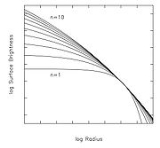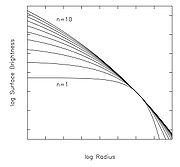
Sersic profile
Encyclopedia
The Sérsic profile is a mathematical function that describes how the intensity  of a galaxy
of a galaxy
varies with distance from its center. It is a generalization of de Vaucouleurs' law. J. L. Sérsic first published his law in 1963.
from its center. It is a generalization of de Vaucouleurs' law. J. L. Sérsic first published his law in 1963.


where is the intensity at
is the intensity at  .
.
The parameter , called the "Sérsic index," controls the degree of curvature of the profile (see figure). The smaller the value of
, called the "Sérsic index," controls the degree of curvature of the profile (see figure). The smaller the value of  , the less centrally concentrated the profile is
, the less centrally concentrated the profile is
and the shallower (steeper) the logarithmic slope at small (large) radii is:

The best-fit value of n correlates with galaxy size and luminosity, such that bigger and brighter galaxies tend to be fit with larger n.
Setting n = 4 gives the de Vaucouleurs profile:
which is a good description of giant elliptical galaxies.
Setting n = 1 gives the exponential profile:
which is a good description of spiral galaxy
disks and dwarf elliptical galaxies. The correlation of Sérsic index (i.e. galaxy concentration) with galaxy morphology is sometimes used in automated schemes to determine the Hubble type of distant galaxies. Sérsic indices have also been shown to correlate with the mass of the supermassive black hole
at the centers of the galaxies.
Sérsic profiles provide the best current description of dark matter halo
s, and the Sérsic index correlates with halo mass.
and Trujillo et al. and further developed by B. Terzić and A. Graham in 2005 to describe such galaxies. Core-Sérsic models have an additional set of parameters that describe the core radius and core density.
Dwarf elliptical galaxies sometimes have pointlike nuclei that are also not well described by Sérsic's law. These galaxies are often fit by a Sérsic model with an added central component representing the nucleus.
The Einasto profile
is mathematically identical to the Sérsic profile, except that is replaced by
is replaced by  , the space density, and
, the space density, and  is replaced by
is replaced by  , the true (not projected) distance from the center.
, the true (not projected) distance from the center.
 of a galaxy
of a galaxyGalaxy
A galaxy is a massive, gravitationally bound system that consists of stars and stellar remnants, an interstellar medium of gas and dust, and an important but poorly understood component tentatively dubbed dark matter. The word galaxy is derived from the Greek galaxias , literally "milky", a...
varies with distance
 from its center. It is a generalization of de Vaucouleurs' law. J. L. Sérsic first published his law in 1963.
from its center. It is a generalization of de Vaucouleurs' law. J. L. Sérsic first published his law in 1963.
Definition
The Sérsic profile has the form
where
 is the intensity at
is the intensity at  .
.The parameter
 , called the "Sérsic index," controls the degree of curvature of the profile (see figure). The smaller the value of
, called the "Sérsic index," controls the degree of curvature of the profile (see figure). The smaller the value of  , the less centrally concentrated the profile is
, the less centrally concentrated the profile isand the shallower (steeper) the logarithmic slope at small (large) radii is:

Applications
Most galaxies are fit by Sérsic profiles with indices in the range 1/2 < n < 10.The best-fit value of n correlates with galaxy size and luminosity, such that bigger and brighter galaxies tend to be fit with larger n.
Setting n = 4 gives the de Vaucouleurs profile:

which is a good description of giant elliptical galaxies.
Setting n = 1 gives the exponential profile:

which is a good description of spiral galaxy
Spiral galaxy
A spiral galaxy is a certain kind of galaxy originally described by Edwin Hubble in his 1936 work The Realm of the Nebulae and, as such, forms part of the Hubble sequence. Spiral galaxies consist of a flat, rotating disk containing stars, gas and dust, and a central concentration of stars known as...
disks and dwarf elliptical galaxies. The correlation of Sérsic index (i.e. galaxy concentration) with galaxy morphology is sometimes used in automated schemes to determine the Hubble type of distant galaxies. Sérsic indices have also been shown to correlate with the mass of the supermassive black hole
Supermassive black hole
A supermassive black hole is the largest type of black hole in a galaxy, in the order of hundreds of thousands to billions of solar masses. Most, and possibly all galaxies, including the Milky Way, are believed to contain supermassive black holes at their centers.Supermassive black holes have...
at the centers of the galaxies.
Sérsic profiles provide the best current description of dark matter halo
Dark matter halo
A dark matter halo is a hypothetical component of a galaxy, which extends beyond the edge of the visible galaxy and dominates the total mass. Since they consist of dark matter, halos cannot be observed directly, but their existence is inferred through their effects on the motions of stars and gas...
s, and the Sérsic index correlates with halo mass.
Generalizations of the Sérsic profile
The brightest elliptical galaxies often have low-density cores that are not well described by Sérsic's law. The "core-Sérsic" family of models was introduced by A. Graham et al.and Trujillo et al. and further developed by B. Terzić and A. Graham in 2005 to describe such galaxies. Core-Sérsic models have an additional set of parameters that describe the core radius and core density.
Dwarf elliptical galaxies sometimes have pointlike nuclei that are also not well described by Sérsic's law. These galaxies are often fit by a Sérsic model with an added central component representing the nucleus.
The Einasto profile
Einasto profile
The Einasto profile is a mathematical function that describes how the density \rho of a spherical stellar system varies with distance r from its center...
is mathematically identical to the Sérsic profile, except that
 is replaced by
is replaced by  , the space density, and
, the space density, and  is replaced by
is replaced by  , the true (not projected) distance from the center.
, the true (not projected) distance from the center.External links
- Stellar systems following the R exp 1/m luminosity law A comprehensive paper that derives many properties of Sérsic models.
- A Concise Reference to (Projected) Sérsic R1/n Quantities, Including Concentration, Profile Slopes, Petrosian Indices, and Kron Magnitudes.

